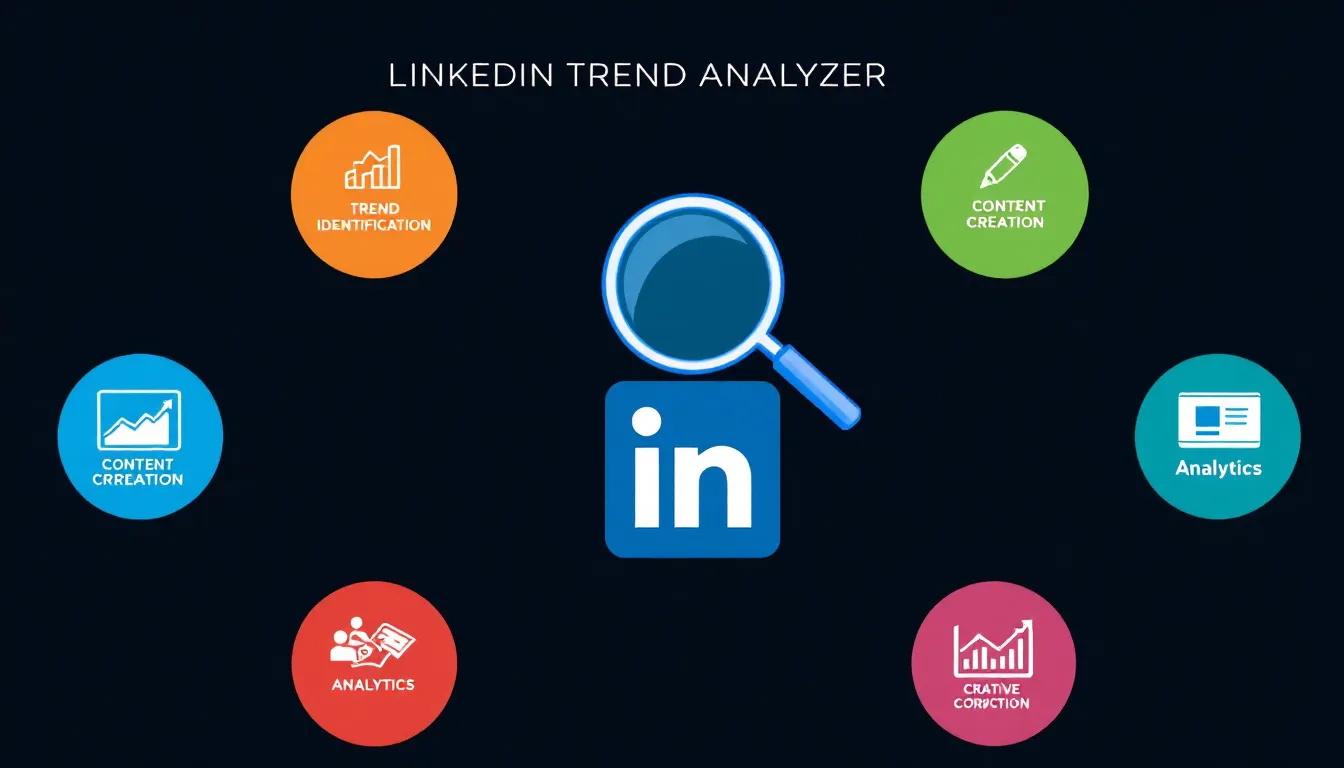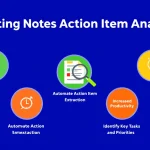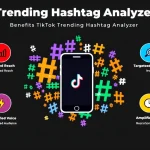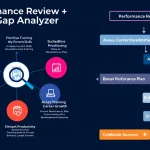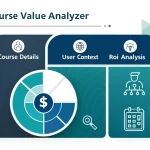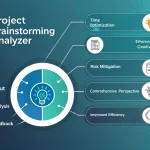Is this tool helpful?
How to Use the LinkedIn Trend Analysis Tool Effectively
To harness the full potential of our LinkedIn Trend Analysis Tool, follow these simple steps:
- Specify Your Industry: Enter the industry you want to analyze in the “Specific industry for which to analyze LinkedIn trends” field. For example, you might input “Renewable Energy” or “E-commerce”.
- Set Time Frame (Optional): In the “Time frame for trend analysis” field, specify the period you’re interested in. For instance, “Last 3 months” or “Past year”.
- Choose Content Types (Optional): Input the specific content types you want to focus on in the “Specific content types to focus on” field. Examples could be “Infographics and video content” or “Long-form articles and polls”.
- Select Key Metrics (Optional): In the “Key metrics to consider” field, enter the metrics you’re most interested in. For example, “Impressions and click-through rates” or “Shares and comments”.
- Analyze: Click the “Analyze LinkedIn Trends” button to generate your comprehensive trend report.
Once the analysis is complete, you’ll receive a detailed report on LinkedIn trends in your specified industry. You can then copy this information to your clipboard for further use in your content strategy or presentations.
Understanding the LinkedIn Trend Analysis Tool: Your Gateway to Strategic Content Creation
In the fast-paced world of professional networking and digital marketing, staying ahead of the curve is crucial. Our LinkedIn Trend Analysis Tool is designed to be your compass in navigating the ever-changing landscape of LinkedIn content. By leveraging advanced algorithms and data analysis techniques, this tool provides you with invaluable insights into the topics, content types, and engagement patterns that are currently resonating with your target audience on LinkedIn.
What Sets Our Tool Apart?
- Industry-Specific Analysis: Unlike generic social media trend tools, our analyzer focuses exclusively on LinkedIn, tailoring its insights to the professional nature of the platform.
- Customizable Parameters: From time frames to content types and key metrics, you have the flexibility to fine-tune your analysis to meet your specific needs.
- Actionable Insights: The tool doesn’t just provide data; it offers actionable recommendations to enhance your LinkedIn strategy.
- Algorithm-Aware: Our tool is constantly updated to align with LinkedIn’s algorithm changes, ensuring your strategy remains effective.
Benefits of Using the LinkedIn Trend Analysis Tool
1. Stay Ahead of Industry Trends
By regularly using our tool, you’ll be among the first to identify emerging trends in your industry. This foresight allows you to create content that’s not just relevant, but forward-thinking, positioning you as a thought leader in your field.
2. Optimize Content Strategy
Understanding what types of content are performing well enables you to optimize your content strategy. Whether it’s long-form articles, short video clips, or interactive polls, you’ll know exactly what resonates with your audience.
3. Enhance Engagement Rates
By aligning your content with current trends and preferences, you’re likely to see a significant boost in engagement rates. This increased interaction can lead to greater visibility, expanded network connections, and potentially, more business opportunities.
4. Save Time and Resources
Instead of spending hours manually researching and analyzing LinkedIn trends, our tool provides you with comprehensive insights in minutes. This efficiency allows you to focus more on content creation and strategy implementation.
5. Data-Driven Decision Making
With our tool, your LinkedIn strategy is no longer based on guesswork. The data-driven insights enable you to make informed decisions about your content strategy, ensuring every post is optimized for maximum impact.
Addressing User Needs: How Our Tool Solves Specific Problems
Problem 1: Lack of Engagement
Many LinkedIn users struggle with low engagement rates on their posts. Our tool addresses this by providing insights into the types of content and topics that are currently driving high engagement in your industry.
For example, let’s say you’re in the cybersecurity industry. The tool might reveal that infographics about recent data breaches are trending. Armed with this information, you could create a visually appealing infographic summarizing recent high-profile breaches and the lessons learned. This timely, trend-aligned content is more likely to garner likes, comments, and shares, boosting your overall engagement.
Problem 2: Inconsistent Posting Schedule
Maintaining a consistent posting schedule can be challenging, especially when you’re unsure about what to post. Our tool solves this by providing a constant stream of trending topics and content ideas.
For instance, if you’re in the HR industry, the tool might show that posts about remote work best practices are gaining traction. You could use this insight to create a series of posts, each focusing on a different aspect of remote work (communication tools, work-life balance, team building activities). This gives you a solid content plan for several weeks, ensuring consistency in your posting schedule.
Problem 3: Limited Network Growth
Struggling to expand your professional network on LinkedIn? Our tool can help by identifying the topics and content types that are most likely to attract new connections in your industry.
Let’s say you’re in the renewable energy sector. The tool might indicate that posts about innovative energy storage solutions are trending. By creating content around this topic, you’re more likely to attract attention from others in your industry, leading to new connection requests and expanding your network.
Practical Applications: Real-World Examples of Our Tool in Action
Case Study 1: Marketing Agency Revamps Client Strategy
A digital marketing agency used our LinkedIn Trend Analysis Tool to revamp their B2B client’s content strategy. The tool revealed that in the software-as-a-service (SaaS) industry, case studies and customer success stories were trending topics.
Based on this insight, the agency shifted their client’s content strategy to focus heavily on showcasing client success stories. They created a series of video testimonials, infographics highlighting key metrics, and long-form articles detailing the problem-solving process.
The result? The client saw a 150% increase in engagement rate and a 75% increase in qualified leads generated through LinkedIn over the next quarter.
Case Study 2: Startup Founder Builds Thought Leadership
A startup founder in the AI industry used our tool to establish herself as a thought leader. The trend analysis revealed that posts discussing the ethical implications of AI were gaining significant traction.
Armed with this information, the founder created a weekly series of posts addressing different ethical concerns in AI development. She also participated in trending discussions, offering her expert insights.
Within six months, her LinkedIn following grew by 500%, and she received invitations to speak at three major industry conferences.
Case Study 3: Job Seeker Lands Dream Role
A job seeker in the finance industry used our tool to optimize his LinkedIn profile and activity. The trend analysis showed that posts about blockchain technology in finance were highly engaging.
The job seeker took an online course in blockchain and started sharing his learnings through LinkedIn posts. He also engaged with trending posts from industry leaders, offering thoughtful comments.
His increased activity and trend-aligned content caught the attention of a fintech startup, leading to a job offer for a role that combined his finance background with his newly acquired blockchain knowledge.
Frequently Asked Questions (FAQ)
Q1: How often should I use the LinkedIn Trend Analysis Tool?
A1: For optimal results, we recommend using the tool at least once a week. LinkedIn trends can change rapidly, and weekly analysis ensures you’re always up-to-date with the latest industry conversations and content preferences.
Q2: Can I use this tool for multiple industries?
A2: Absolutely! Our tool is designed to analyze trends across various industries. You can run separate analyses for different sectors, making it ideal for agencies managing multiple clients or professionals interested in cross-industry insights.
Q3: How does the tool determine what’s trending?
A3: Our tool uses a combination of factors to identify trends, including engagement rates (likes, comments, shares), content virality, keyword frequency, and user interaction patterns. It also takes into account LinkedIn’s algorithm preferences to ensure the trends identified are likely to perform well on the platform.
Q4: Can this tool help with LinkedIn ads strategy?
A4: While our tool is primarily designed for organic content strategy, the insights it provides can certainly inform your LinkedIn ads strategy. Trending topics and content types can be excellent starting points for creating targeted ad campaigns that resonate with your audience.
Q5: Is this tool suitable for both personal branding and company pages?
A5: Yes, our LinkedIn Trend Analysis Tool is valuable for both individual professionals and company page managers. The insights can be applied to personal branding efforts as well as corporate content strategies on LinkedIn.
Q6: How far back does the trend analysis go?
A6: Our tool can analyze trends from the past week up to the past year, depending on your specified time frame. This flexibility allows you to identify both emerging short-term trends and longer-term industry shifts.
Q7: Can I export the trend analysis results?
A7: Yes, you can easily copy the analysis results to your clipboard using the “Copy to Clipboard” button. From there, you can paste the insights into any document or presentation for further use or sharing with your team.
Q8: Does the tool provide content ideas or just trend data?
A8: While the primary function of our tool is to provide trend data, the insights often naturally lead to content ideas. The trending topics, content types, and engagement patterns can serve as excellent inspiration for your content creation process.
Q9: How does this tool compare to LinkedIn’s built-in analytics?
A9: Our LinkedIn Trend Analysis Tool complements LinkedIn’s built-in analytics. While LinkedIn’s analytics focus on your own page’s performance, our tool provides broader industry-wide insights and trends, helping you stay ahead of the curve rather than just analyzing past performance.
Q10: Can this tool predict future trends?
A10: While our tool doesn’t claim to predict the future with certainty, it does identify emerging trends that are gaining momentum. By regularly using the tool, you can spot patterns and shifts early, allowing you to anticipate and prepare for future trends in your industry.
By leveraging the power of our LinkedIn Trend Analysis Tool, you’re equipping yourself with the insights needed to create a compelling, engaging, and effective LinkedIn presence. Whether you’re looking to boost your personal brand, grow your company’s influence, or simply stay ahead of industry conversations, our tool provides the data-driven foundation for your success on the world’s largest professional network.
Important Disclaimer
The calculations, results, and content provided by our tools are not guaranteed to be accurate, complete, or reliable. Users are responsible for verifying and interpreting the results. Our content and tools may contain errors, biases, or inconsistencies. We reserve the right to save inputs and outputs from our tools for the purposes of error debugging, bias identification, and performance improvement. External companies providing AI models used in our tools may also save and process data in accordance with their own policies. By using our tools, you consent to this data collection and processing. We reserve the right to limit the usage of our tools based on current usability factors. By using our tools, you acknowledge that you have read, understood, and agreed to this disclaimer. You accept the inherent risks and limitations associated with the use of our tools and services.
